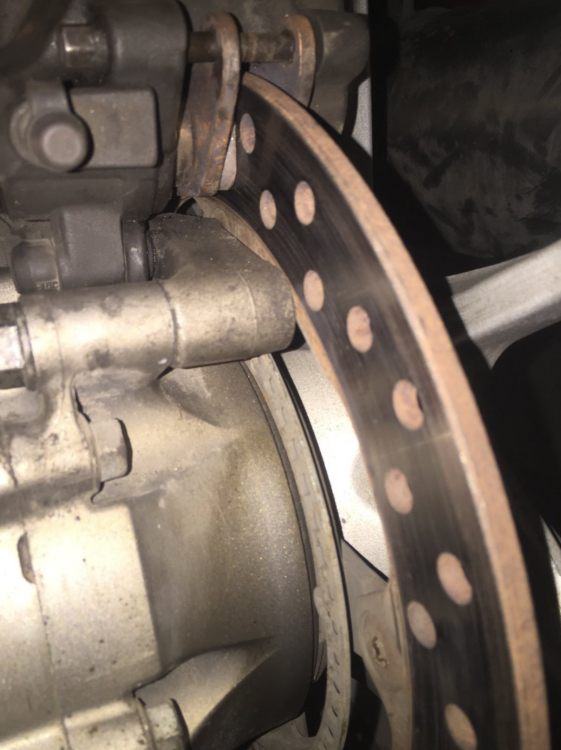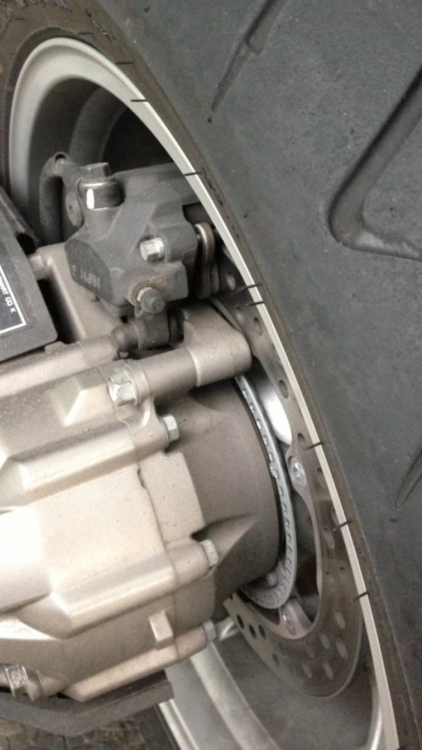
darkcider
-
Posts
14 -
Joined
-
Last visited
Content Type
Forums
Profiles
Gallery
Blogs
Downloads
Events
Posts posted by darkcider
-
-
Just been travelling on the motorway and looked down to see the dash instruments all dead and the HISS light blinking, yet the engine was still running fine!!
Got home, checked and the 10A Stop/Tail/Meter fuse had blown. Meter backup still good. Replaced with the spare 10A and switched on. Clocks lit up briefly then went out. Engine starts and runs fine, but no clocks, no indicators, no tail lights. Any ideas?? Rode home last night in a heavy rain-storm, but the bike was fine and was also fine on the run in to work this morning, so not sure water ingress is the cause. -
Thanks Thumbs. I tend to change the final drive oil every time i do the engine oil, s0 around every 8k miles. I found it pretty alarming that such heat could build up in a relatively short journey, no more than 20 mins - and cause so much weight of metal to heat up - the entire swingarm housing, the final drive, the caliper and wheel rim were all very hot.
-
Thanks for your measurements Andy - interesting that there's been only a 13ºC rise. I'd estimate that mine was up to around 65-70ºC after a 15 mile fast motorway trip (3 figure speeds).
-
How hot does your final drive housing and swing arm get?
I know it's 35-ish degrees in the UK at the moment, but mine is getting to the point of being too hot to touch with a bare hand for more than a second or two.
Although I've posted elsewhere about my issues with clearances on my final drive, there's no drag from the pads and no rubbing or fouling of the disc on the caliper mount. There's the correct amount of oil in the final drive housing too and no signs of a leak.
The bike was a 2 years newer when I had the recall work done, but it's never been the same since going into the workshop and I'm wondering if something is amiss - there's no noticeable slop in the drive or odd noises (other than the hunting when in Drive mode at low speeds - yes it's a DCT). -
19 hours ago, BiKenG said:
Although it has been stated as such, that could not have been the real reason as the CrossTourer engine is almost identical yet passes the latest emissions regs. So there is NO way Honda could not get the F certified - if they wanted to. Fact was, sales were so low it wasn’t worth even that minimal effort so cheaper to kill it off, blaming emissions while thinking they saved face by not admitting it was a sales flop. It should and could have been a great success, but they blew it.
In so many ways now, Honda just doesn’t seem to know what it’s doing.
The thing is that the CrossTourer is vastly de-tuned in comparison to the F version - this allows Honda to achieve the stringent emission standards for the X.
Very kind of you to offer the spare final drive. I think I’ll buy one from a breaker and have it ready for when I strip and inspect mine. I suspect that some sort of misalignment of the pads or caliper have resulted in the disc carrier being warped/dished. There’s a step in the rotor carrier (which is a cast piece, not forged) and at the step, the metal of the carrier is very thin - only around 2mm thick. With the excess heat and forces involved, it wouldnt surprise me if the rotor carrier was bent to the left at this point.
-
I'll use the torx bolts that hold the ABS sensor ring as a datum - they appear to run almost exactly in line with the edge of the housing. If it turns out that the rotor carrier is warped, I'll get it pressed back into line, as a new part is around £400 believe it or not!!
-
Ha! C'mon Honda indeed. I do wish they'd kept the VFR1200F in the model range now, instead of killing it off in Europe due to the emissions rules.
The caliper in sliding correctly - pins greased and boots all intact. When you remove the caliper and just leave the caliper mount installed, the disc rotor doesn't sit central to the gap in the mount. I really am starting to suspect warping rather than anything else. I note that clearance on yours is only in the region of 1mm anyway, so even minor fluctuations in rotor carrier true-ness clould account for the lack of gap.
I'll do a closer inspection next time I have a day off. 3 week old child is taking up a lot of time at the moment!!
-
The thing that really confounds me is that the gap between the ABS ring and the hub housing is pretty much identical from the two photos above. This would indicate that either the rotor carrier or the rotor itself is warped or dished.
-
On DCT models, the main brake is mounted on the top of the swingarm and the parking brake (which is useless and has been removed) lives underneath. I have had the caliper off and completely stripped and cleaned. The issue isn’t really with the caliper though, it’s with the mounting bracket which bolts to the final drive housing and is virtually touching the disc rotor.
I am going to have to strip down and inspect the hub as I really do suspect that there’s a spacer or some other component missing.
-
The shims come as pairs and if you use a thicker shim at one end of the bevel gear shaft, you use the correspondingly thinner shim at the other end of the shaft, which allows the gears to be moved relative to one another, but keeps the overall stack height of the output shaft the same.
I'm with you though in thinking that there could be a component missing from the assembly - I'll have a look and strip it down myself, as the bike is out of warranty and even if there was a componenet missing, I bet I'd get charged for repair and labour, as they'd say it couldn't possibly be missing from new (and I am the first and only owner).
-
Thanks for the reply. My bike had the drive shaft recall work done around 2 years ago now. As you say, the only component changed was the universal joint, not the final drive components. Sadly, I don't have much faith that Honda dealers here will be able to help, as the answer isn't in the workshop manual.
All I can think of is that when doing the recall work, the bevel box housing has to be removed/disassembled and something hasn't been put back right.
-
Hi all, had the rear brake lock up on me recently after a high speed run in temps of 100degrees. After all had cooled down and I got home, I inspected the rear to see that the caliper mount casting was rubbing on the rotor ever so slightly and that the rotor wasn't running centrally in the cut-out in the mount. ABS ring was also pretty much touching the sensor. Pics show what I mean - the one with the tyre in shot is when I bought the bike new, the close up is from the other day.
Reading the manual, there's no mention of shims or spacers to get the rotor in the correct positon - just shims to adjust the final drive bevel gears relative to one another. So has there been some warping or dishing of not only the rotor but the flange that hold the rotor?? Would it be safe to shim out the rotor assembly by using washers over the 5 wheel studs? We're only talking about 1.5 to 2mm here.



Big H Issued A Recall On Vfr1200F And Vfr1200X Re:drive-Shafts
in Seventh Generation VFR's
Posted
So, although I've supposedly had the new shaft fitted by a local dealer, I can't find any punch marks on the subframe, or below the first digit of the frame number, so I'm curious as to what has actually been done.
Also, ever since the work was carried out, my rear brake calliper carrier has been pretty much touching the brake rotor and although the bike runs great, I have no confidence in the rear brake, as the odd time I've used it, it's ended up binding due to heat and expansion. (See photo of just how close the clearance is on my rear hub - it's as though the disc carrier is seated too far into the FD).
So, I'm replacing the final drive with a different one, where the calliper carrier is in the correct position. Which brings me to the nub of my post:
When removing the final drive/shaft, how the heck do you remove the shaft from the FD pinion gear?? I've followed the manual, turn slowly while gently pulling on the CV joint, but it's not budging. How much force does one need to put in to separate the two??